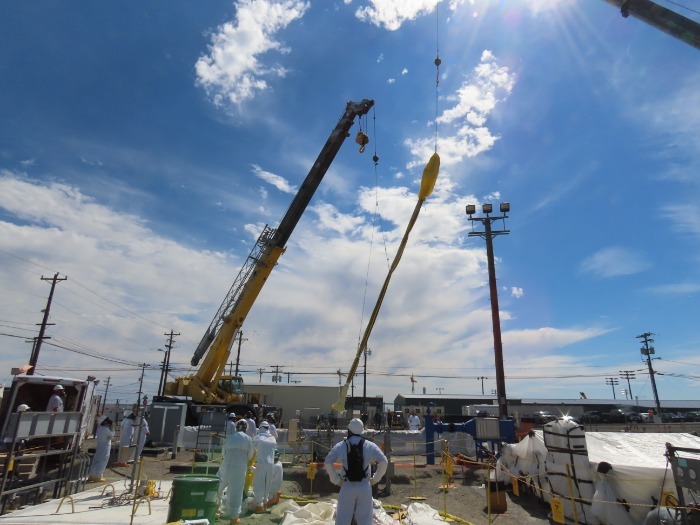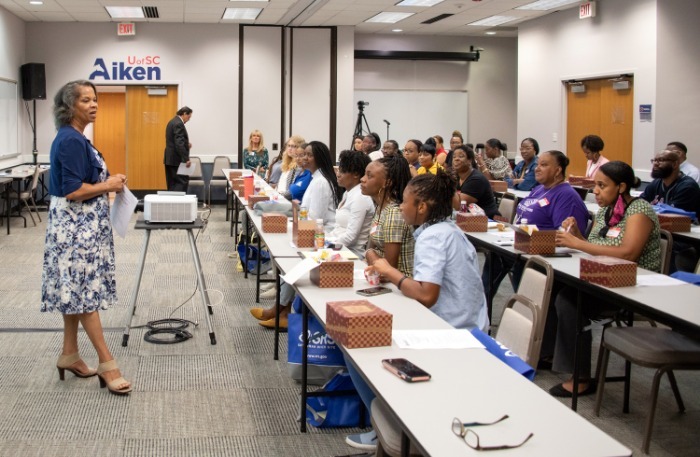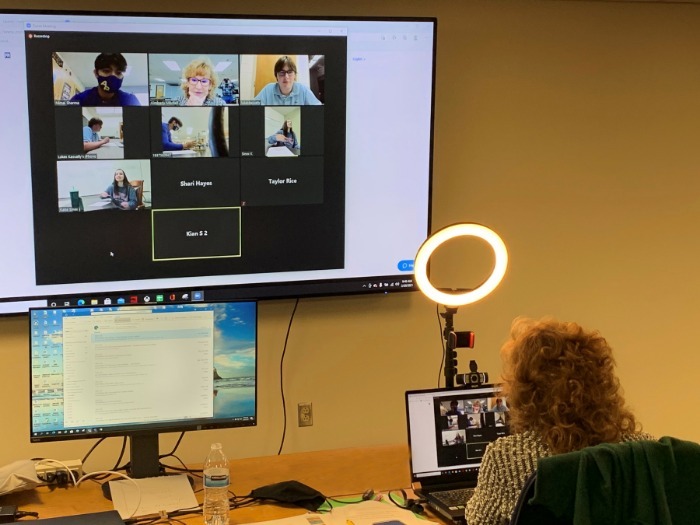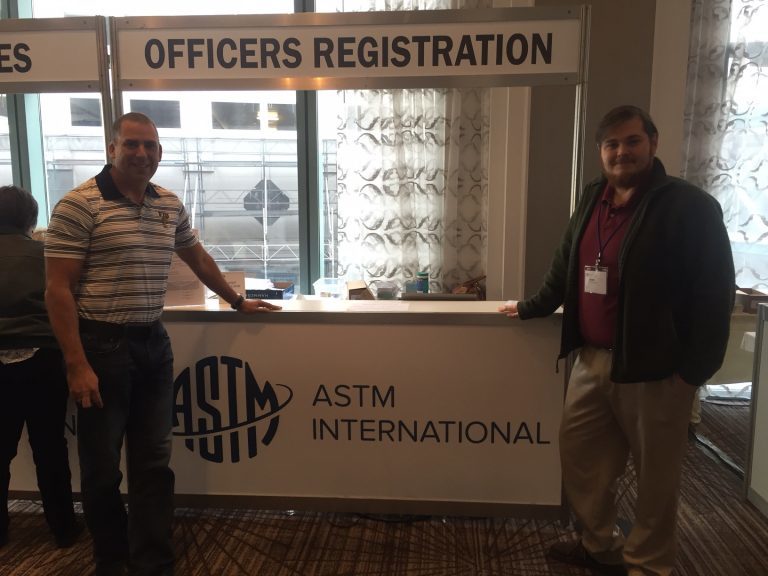 Workers remove a pump from Double-Shell Tank AW-102, allowing for the installation of a new pump to feed waste to the Hanford Site's 242-A Evaporator.
RICHLAND, Wash. – EM Office of River Protection tank operations contractor Washington River Protection Solutions (WRPS) recently took a significant step in ensuring continued safe storage of radioactive and chemical waste with the removal of a waste transfer pump from a double-shell tank.
Workers removed the 45-foot-long pump assembly from the tank and packaged it in a concrete disposal box for shipment to Hanford’s Environmental Restoration Disposal Facility.
Removing the pump from Tank AW-102 set the stage for workers to install a new pump in the 1-million-gallon-capacity tank.
“Tank AW-102 is the feed tank to Hanford’s 242-A Evaporator, which plays a critical role in the Hanford cleanup mission by boiling off water from tank waste to create more storage space in the double-shell tank system,” said Ricky Bang, EM tank farms program division director.
 |
|
Hanford Site workers remove a waste transfer pump from a double-shell tank, a significant step in ensuring continued safe storage of radioactive and chemical waste. |
In recent years, WRPS has developed and deployed many unique tools that have enhanced worker safety and project efficiency when removing long-length pumps that transfer waste, sluicers to break up and retrieve waste, and thermocouples that monitor waste temperature.
The project to remove the pump from Tank AW-102 featured two new improvements for removing equipment from tanks: a high-pressure rinse to remove contaminated materials and a beta shielding bagging system that wraps equipment to control any remaining contamination.
“Removing contaminated long-length equipment is a high-risk activity that we will perform repeatedly to progress our mission, and we continue to identify ways to work more efficiently, reduce risk, and overcome challenging conditions,” said Jim Geary, manager of the WRPS tank farm projects organization.
−Contributor: Mark McKenna
 Rev. Brendolyn Jenkins Boseman, executive director of the The Imani Group, Inc., speaks to middle and high school teachers during the annual Teaching Radiation, Energy and Technology Workshop in Aiken, South Carolina.
AIKEN, S.C. – About 30 local middle and high school teachers came together recently at the University of South Carolina Aiken for the Teaching Radiation, Energy and Technology (TREAT) Workshop, an event for local educators held by the DOE Savannah River Operations Office since 1995.
Through an environmental justice grant, DOE partners with Savannah State University (SSU) to develop and carry out these important workshops. The goal is to educate teachers of kindergarten through twelfth grade and local community leaders in the Central Savannah River Area about radiation, sources of radiation, radioactive waste management, effects of radiation on environmental health, and the negative impact of environmental radiation exposure to humans.
The workshops are designed to educate the teachers so they can in turn provide radiation education to their students, and even encourage them to pursue careers in engineering and nuclear fields. Experts from DOE, Savannah River Site (SRS), the Environmental Protection Agency, and South Carolina Department of Health and Environmental Control come together to teach, answer questions, and discuss potential career opportunities.
Melinda Downing, DOE’s environmental justice program manager, welcomed the group and emphasized the importance of the workshop, during which participants heard about the history and missions of SRS, Radiation 101, Environmental Monitoring: Wildlife Surveillance Program, and Emergency Preparedness.
Taylor Rice of Savannah River Nuclear Solutions (SRNS) provided an overview of the SRNS Education Outreach program. SRNS is the management and operations contractor at SRS.
“This is a great opportunity for teachers to learn about all the different missions that make up SRS and how we work to meet the needs of the communities near the site,” Rice said.
Rev. Brendolyn Jenkins Boseman, executive director of the Imani Group, Inc., a local community-based organization that provides leadership and diversity training, facilitated the workshop and shared her experience during her presentation, “Environmental Justice 101 - Community Perspective.”
Mindy Mets, director of regional workforce programs for the Savannah River Site Community Reuse Organization, provided an overview of nuclear technology regionally and globally.
SRS Environmental Justice Program Manager de’Lisa Carrico, the workshop coordinator, noted the high value placed on this type of communication with local teachers and community leaders.
“For several years now, we’ve added a second workshop for faith-based and community leaders,” said Carrico. “The participants have been highly engaged in productive discussion and have also expressed their appreciation for this special opportunity.”
“Working closely with Dr. Kenneth Sajwan, the project director at SSU, and Rev. Boseman, we’ve conducted a series of activities promoting environmental justice in addition to the TREAT workshops," Carrico said. "For example, we hold environmental justice outreach meetings in different locations throughout the region where the public is invited. To best reach this audience, we usually meet in the evenings at churches where we offer fellowship and dinner along with site information. This approach has been quite successful as well.”
This collaboration strengthens meaningful public involvement in adversely impacted communities and is recognized as a model environmental justice program for communities around federal facilities.
“We hope that everyone who is touched by this extensive program, at the least, comes away with a general idea of what is accomplished at SRS and are comfortable with our dedication to safety, community outreach, and environmental management,” Carrico said.
–Contributor: DT Townsend
 “Feathers in the Forest” is the second in a series of videos to help students virtually visit the Savannah River Site.
AIKEN, S.C. – Last year, Savannah River Nuclear Solutions (SRNS) Education Outreach programs faced daunting limitations due to the COVID-19 pandemic, but the organization saw an opportunity to enhance and extend the reach of their broad range of initiatives despite these challenges.
Kim Mitchell, with the SRNS Education Outreach programs, said the staff explored and optimally utilized virtual tools in place of face-to-face communication. SRNS is the management and operations contractor at the Savannah River Site (SRS).
“Adopting a new web-based approach to meet the needs of those participating in our various programs required a fast and steep learning curve for us. This was true for the participating educators and students, as well. That said, the end result was a high level of success combined with a rewarding experience,” said Mitchell.
“By providing new and innovative virtual opportunities to our schools, we were able to reach more students and educators than ever before,” said Taylor Rice, with SRNS Education Outreach programs. “Offering web-based programs allowed schools throughout the region the opportunity to participate in our competitions and programs, without travel being a problem.”
 |
|
Kim Mitchell, with Savannah River Nuclear Solutions Education Outreach programs, leads participants through this year’s virtual South Carolina Regional Science Bowl competition, which involved a significant learning curve for all involved. |
Mitchell explained that the benefits found through efforts to work through the pandemic will continue to play an important role in the future of education outreach. Examples include the creation of a new program, STEMulating Conversations with Savannah River Site Experts, as well as video and virtual reality programs that bring SRS to classrooms throughout South Carolina and Georgia.
“Our Wet Wonders and Feathers in the Forest videos demonstrate the value of this concept,” said Mitchell. “In the past, we brought a limited number of groups of students each year to SRS for a series of ‘hands-on’ environmental science experiments and lessons. Though I'm confident we will return to this popular method, we will also continue to reach deeply into classrooms throughout our region — and beyond — with the current and future videos, plus virtual reality programming.
“We recently completed and made available a science-based video on how a mass spectrometer functions. Students journey through this highly sensitive piece of equipment by riding on an electron beam to demonstrate the spectrometer’s ability to identify the molecular makeup of a substance. It will soon be added to our new web-based library as a virtual reality program as well," Mitchell added.
Demand for these videos is quickly growing. To date, more than 23,000 students have seen the videos, and educators have received corresponding guides.
“It’s important to credit the value of this new approach to members of our video production, graphics, laboratory, research and development engineering, and information technology groups within SRNS,” said Mitchell. “They stepped up and teamed up with us in our hour of need. None of this would have been possible without their assistance.”
–Contributor: DT Townsend
Collaboration between EM and the American Society for Testing and Materials (ASTM) International has yielded five new standards and testing practices for fixatives — the latest being approved earlier this summer.
EM proactively solicits and evaluates initiatives to support the safe and efficient decommissioning of legacy nuclear facilities. The latest achievement capitalized on research led by the Savannah River National Laboratory (SRNL) and the Applied Research Center at Florida International University (FIU).
Their work led to the development of intumescent coatings as fire resistant fixatives — an intumescent is a substance that swells up when heated and protects underlying material. In this case, the technology was applied to the development of certain fixatives that are applied to “seal in” contamination to avoid risk of exposure on structures being prepared for deactivation.
 Joseph Sinicrope, left, Florida International University Applied Research Center, serves as the E10.03 Subcommittee Chair and Connor Nicholson, Savannah River National Laboratory, serves as the E10.03 Vice Chair.
Through SRNL and FIU participation on the ASTM E10.03 Subcommittee on Radiological Protection for D&D of Nuclear Facilities and Components, EM collaborated with the organization, which develops and publishes technical standards for a range of materials and products.
The E10.03 Subcommittee initiated a working group in June 2021 to develop a standard specification for dust suppressant fixative technologies intended to support open-air demolition and decommissioning, and the group is on track to release its initial draft for a stakeholder ballot no later than January 2022.
EM will continue to leverage this partnership with ASTM to facilitate uniform testing and evaluation of decommissioning technologies.
–Contributor: Joseph Sinicrope
|